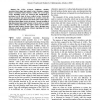Free Online Productivity Tools
i2Speak
i2Symbol
i2OCR
iTex2Img
iWeb2Print
iWeb2Shot
i2Type
iPdf2Split
iPdf2Merge
i2Bopomofo
i2Arabic
i2Style
i2Image
i2PDF
iLatex2Rtf
Sci2ools
IJCNN
2006
IEEE
2006
IEEE
SOM-Based Sparse Binary Encoding for AURA Classifier
—The AURA k-Nearest Neighbour classifier associates binary input and output vectors, forming a compact binary Correlation Matrix Memory (CMM). For a new input vector, matching vectors are retrieved and classification is performed on the basis of these recalled vectors. Real-world data is not binary and must therefore be encoded to form the required binary input. Efficient operation of the CMM requires that these binary input vectors are sparse. Current encoding of high dimensional data requires large vectors in order to remain sparse, reducing efficiency. This paper explores an alternative approach that produces shorter sparse codes, allowing more efficient storage of information without degrading the recall performance of the system.
| Added | 11 Jun 2010 |
| Updated | 11 Jun 2010 |
| Type | Conference |
| Year | 2006 |
| Where | IJCNN |
| Authors | Simon O'Keefe |
Comments (0)

